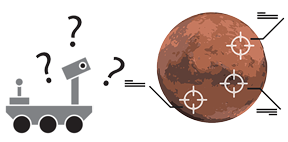Remote Sensing and Mars
Youth explore the idea that NASA scientists are interested in finding evidence of past water on Mars that would indicate habitability. They are challenged to select one of four landing sites for a rover by examining high-resolution images of landforms on Mars.

Setup
The Educator Guide has a script, materials list, and prep directions. Be sure to have it open and ready to help guide you through every activity.
- Read through the entire PLANETS Science Series guide.
- Print or copy Science Notebooks, one for each youth.
- Print or copy, and staple Data Packets, Landforms Glossary, and Mineral Data Sheets, from the Educator Guide (color if possible), one for each group.
- Print or copy Landing Ellipses and cut out for each group.
Related Video
Curiosity’s Seven Minutes of Terror
Youth Will Know
- NASA is interested in learning whether Mars could have once supported life.
- Life on Earth depends on water.
- NASA spacecraft take pictures of Mars and send the images back to Earth as data.
Youth Will Do
- Compare landforms on Earth and Mars.
- Interpret image data to find safe and scientifically interesting locations.
Did you know?
Mars still has water; it is just mostly in the form of ice at the poles or trapped in minerals and underground.
Quick Tips
- The Viking, HiRISE, and CTX images are at different scales. The ellipses are to be traced on the CTX (10 km scale bar) images only.
- If your Data Packet prints out small, your landing ellipses will be too big. Have your students draw their own with a pencil.
